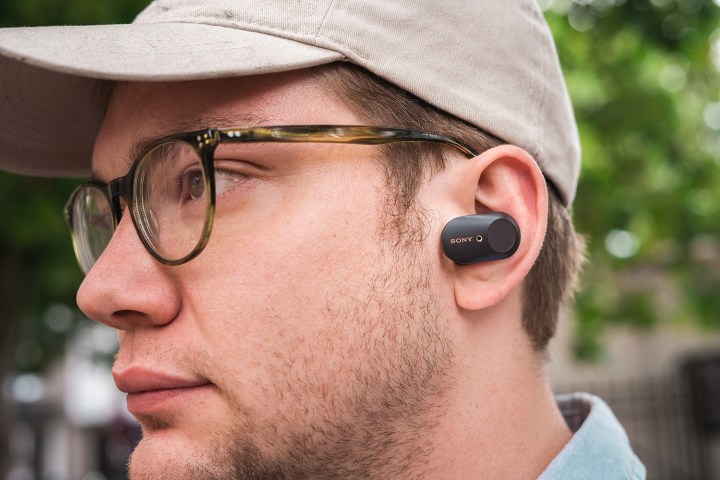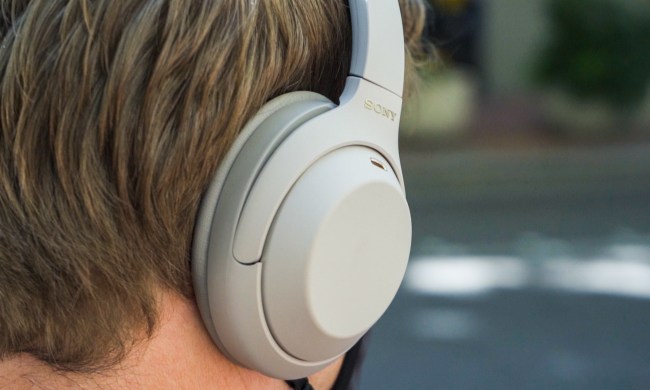Sony’s excellent WF-1000XM3 have been prominent members of our best true wireless earbuds list ever since they debuted in 2019. Thanks to their combination of sound quality, battery life, call quality, and active noise cancellation (ANC), we still consider them the best overall true wireless earbuds you can buy.
This year, Sony released the WF-SP800N, a set of true wireless earbuds designed for sports and active lifestyles in general. On paper, the WF-SP800N appear to outclass the older WF-1000XM3 in several key categories like battery life, water resistance, and price. At $200, the SP800N are $30 less than the $230 1000XM3.
Does this mean that the newer WF-SP800N are the better buds and the obvious choice for buyers looking for a set of premium true wireless earbuds? Let’s see how they really compare.
Price

You might think that at $200 for the WF-SP800N and $230 for the WF-1000XM3, this one is a no-brainer, right? The SP800N are clearly more affordable.
When both models go on sale — which tends to happen at the same time — the price difference can be as little as $10, with the 1000XM3 going as low as $180 and the SP800N hitting $170. That’s a good reason to pay close attention to Sony’s website and your favorite electronics retailers.
However, purely on the basis of their manufacturer’s suggested retail prices (MSRP), we’ve got to give this one to the WF-SP800N.
Winner: WF-SP800N
Battery life

Sony’s WF-1000XM3 were one of the earliest true wireless earbuds to hit the market with full ANC, but they didn’t sacrifice battery life in order to do it. They boast six hours of listening time with ANC turned on and a very respectable eight hours when it’s turned off. Compare that to Apple’s AirPods Pro (4.5 hours with ANC, 5 hours without ANC), and it’s easy to see why the WF-1000XM3 have remained so popular.
However, there’s always room for improvement. Since the 1000XM3’s debut, we’ve seen newer ANC earbuds take battery life to the next level, like Master and Dynamic’s MW07 Plus, which can keep the tunes going for 10 hours with ANC turned on.
Not to be outdone, the WF-SP800N can best be described as Sony’s “hold my beer” response in the battery life wars. They can run for nine hours with ANC on and a battery-busting 13 hours with the feature disengaged. For those who are keeping score, that’s the longest run time you can get on a set of true wireless earbuds, with or without ANC.
When you’re the best, it’s no contest.
Winner: WF-SP800N
Water and dust protection

Protection from the elements is another feature that premium ANC earbuds have largely struggled to implement. The WF-1000XM3 can withstand some sweat, but officially speaking, they are not IPX-rated by Sony, so expose them to water at your own risk. Apple’s AirPods Pro and Sennheiser’s Momentum 2 True Wireless are IPX4, or what we tend to think of as a good amount of water resistance for daily-use earbuds. Master and Dynamic’s MW07 Plus up the ante a little with IPX5.
On the other hand, Sony’s WF-SP800N go the farthest, with IPX55 — a rating that protects from both dust and water — for the best protection you can get in a set of true wireless earbuds that feature ANC.
The SP800N declare victory again, by not just going beyond the WF-1000XM3, but also killing the rest of the competition.
Winner: WF-SP800N
Design

When it comes to the design of these two sets of true wireless earbuds, Sony has taken a very practical approach. The WF-1000XM3 were designed for general daily-use and travel, and as such, they emphasize style, comfort, and convenience. The charging case uses NFC for rapid and easy pairing with Android phones, and it sits in the middle ground in terms of size: The case is bigger than the ultra-small AirPods Pro case, yet smaller than the one that comes with the Momentum True Wireless 2 or MW07 Plus. The earbuds come with a generous selection of six different silicone ear tips to help you get the best possible fit.
The WF-1000XM3 earbuds use touch-sensitive controls that can be customized inside the free Sony Headphones Connect app, and on-board sensors automatically pause the music when you remove an earbud. Overall, though not as compact as some other earbuds, the WF-1000XM3 are nonetheless very comfortable and easy to use.
The WF-SP800N start with that same basic design and add greater security through the use of flexible ear fins, which help to lock the earbuds in place during strenuous activity. With the exception of a slight taper on one end of the earbud’s outer shell, there’s very little difference between the two models. The SP800N’s charging case is slightly more compact but lacks the 1000XM3’s NFC feature and its elegant copper lid. Additionally, the SP800N only come with three sets of silicone ear tips and two sets of ear fins.
Some people will find the 1000XM3 more comfortable for longer periods because they don’t rely on an ear fin to stay in place. We tried using the SP800N without their ear fins to see if they could offer the best of both worlds, and it’s close: They definitely stay in your ear, but they’re not as stable as the 1000XM3, and we don’t recommend using them this way for workouts.
With so few variances between Sony’s ANC earbuds, we’re going to call this one a tie.
Winner: Draw
Noise cancellation

Since they debuted, the WF-1000XM3 have had some of the best ANC we’ve ever tested in a set of true wireless earbuds. Much to our surprise, Apple’s AirPods Pro are even better. The AirPods Pro are $20 more expensive than the 1000XM3, so in some ways, that makes sense. The WF-SP800N, however, are less expensive — does that mean their ANC isn’t as good?
Technically speaking, the answer is yes, and that’s because the WF-1000XM3 use Sony’s proprietary HD Noise-Canceling Processor QN1e, the same chip used in the company’s superb WH-1000XM3 noise-canceling headphones. Sony doesn’t specifically say which noise-canceling tech resides inside the WF-SP800N, but you know that if Sony felt it were better than the QN1e, we’d know all about it.
In the real world, it is doubtful that there is even a 10% difference in the effectiveness of the two models when it comes to blocking out sounds. For testing purposes, our pandemic-based equivalent to airplane white noise or standard office activity was a vacuum, a noisy bathroom extractor fan, and a construction crew outside the house. Neither the SP800N or 1000XM3 could completely cancel these sounds when sitting right beside them, but even at three to four feet away, both sets of earbuds magically reduced those sounds pretty much identically. The WF-1000XM3 may have been slightly better, but it was really too close to call.
Winner: Draw
Call quality

If, when calling people using your true wireless earbuds, you had to pick between how well background sounds were canceled and how clear your voice sounded, which would you pick? The answer to that question pretty much determines which of these two models get the nod for call quality.
The WF-1000XM3 are more effective than the WF-SP800N at dealing with passing cars, talking pedestrians, and any number of other background sounds — and your callers will sound very clear to you. However, your voice may suffer from what I can best describe as a “wibbly-wobbly” effect to the other end of the line.
The SP800N, by contrast, are great for delivering your voice at the same quality as you’d get using your phone’s mic, but your callers will have to contend with the noises around you.
It’s a frustrating conundrum: The earbuds that you’re more likely to use in noisy environments like the gym or while running don’t cancel noises as well as the buds meant for quieter locales, and the buds best suited for everyday use in those quieter spaces don’t transmit your voice particularly clearly.
Pick your poison, as this one’s another tie.
Winner: Draw
Sound quality

For some buyers, this is the category that matters the most. If you count yourself among these folks, listen up: The WF-1000XM3 sound better. We’ll qualify that statement: You would need to be in a perfectly quiet environment to be able to enjoy the 1000XM3’s performance, and you’d need to be the kind of person for whom subtleties matter in order to appreciate that performance.
The SP800N sound great. They deliver rich, full sound, and there’s tons of bass on tap for those who want their workouts driven by the beat. The 1000XM3, on the other hand, offer up the same raw acoustics, but there’s an additional level of detail and refinement. The vocals are just a little clearer, the midranges just a little better defined, and the bass somehow manages to always compliment and never command the rest of the track.
The 1000XM3 earbuds also benefit from Sony’s DSEE HX technology, which does an admirable job of improving the quality of compressed digital music tracks like MP3 and AAC.
It’s subtle, but it’s noticeable. For that reason, the WF-1000XM3 take this one.
Winner: WF-1000XM3
Conclusion
Are the WF-SP800N the winners here? Absolutely. They crush it in all of the areas that we’ve been able to quantify or qualify. They don’t just measure up well compared to the WF-1000XM3 — they give it and all other ANC earbuds some serious competition.
There’s only one area where SP800N don’t dominate: Sound quality. For some folks, that’s the competition in two words. For these buyers, all we can say is, if sound quality matters more than battery life, water and dust protection, or price, stick with the WF-1000XM3. That is, until Sony releases the WF-1000XM4, which might not be all that far away.



